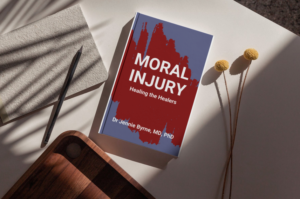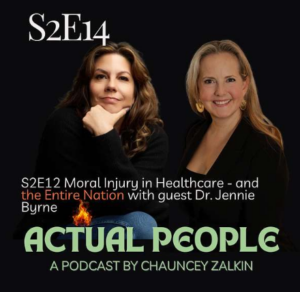Redirected Anger
Healthcare workers are six times more likely to experience violence in the workplace than the average worker in the United States. In a poll of emergency physicians, 47% said they had been physically assaulted while at work, with over half saying patients had also been injured (Almendral, 2022; Violence in the ER, 2023).
One of the ways that human beings process anger and pain is to direct those feelings away from the self and back out into the world, especially onto other people. When the person does not have words to communicate how they are feeling, they may act out the emotion through their behavior.
When physicians and other clinicians are suffering from moral injury, they often do not have words to describe what they are feeling. It has become popular to talk about burnout, but burnout is different than moral injury.
What is the difference between burnout and moral injury?
According to the APA Dictionary of Psychology, burnout is defined as “physical, emotional or mental exhaustion, accompanied by decreased motivation, lowered performance and negative attitudes towards oneself and others.”
Moral injury, on the other hand, is understood to be the strong cognitive and emotional response that can occur following events that violate a person’s moral or ethical code.
Talking about burnout can do more harm than good. When someone is experiencing moral injury and you tell them they are experiencing burnout, you are not validating their feelings. In fact, you are telling them that they just need to rest to get past their exhaustion and then everything will be fine.
Rest will not fix moral injury.
If we don’t start talking about moral injury, our clinicians will not have the vocabulary to express what they are experiencing. Being human, those emotions have to go somewhere. They may end up being directed towards others as anger, frustration, or other unhealthy behaviors.
What are some examples of anger and acting out in the medical setting?
A physician experiencing moral injury in the hospital where there is a nursing shortage may get frustrated with the nurse on her team for not finishing her tasks quickly enough. She then criticizes them publicly in front of others, making the nurse feel terrible.
A nurse experiencing moral injury in an infusion center where she has an endless checklist of administrative tasks may get annoyed with a nervous elderly lady who wants to chat for a few minutes. She rushes through the IV setup and closes the curtain so she doesn’t have to see the elderly lady during her treatment.
A physician assistant experiencing moral injury in a primary care practice where he feels the leadership treats him like a cog in a machine will focus his energy on getting his charting done, so he stops making eye contact with patients and gets annoyed when they want him to have a deep conversation.
Giving voice to the underlying problem of moral injury is the first step. When leaders talk about moral injury, they validate the experience of the clinician. Remember that one of the key steps towards healing moral injury is to give voice to the value that is being transgressed.
So, in the examples above:
The hospital leadership can have a frank conversation about the nursing shortage. They can ask questions and listen to how this is impacting the rest of the staff. They can articulate how having a nursing shortage creates difficult situations for the providers and how this might be causing moral injury.
The primary care practice leader can have a neutral party come in to have qualitative and quantitative interviews with the staff, and shadow them for a day. The leader can then share the results of the interviews with the clinicians, validating their feelings. The leader can then talk about how the system is creating moral injury, and start a conversation with the clinicians about how they can move forward together.
The IV infusion center can do a time study on the various administrative tasks and how it impacts the nurses’ daily routines. They can bring together the nurses and talk about the feeling of moral injury they are experiencing. They can then start to look at the data together and look for opportunities to improve the administrative tasks in a way that keeps the infusion center compliant but also decreases demands being put on the nurses.
The key first step is to call out when moral injury is happening. It must be the leadership who calls it out and names it. This is the first step in healing.
If we do not call out moral injury by name, then we can never heal it. Physicians and other clinicians will continue to act out, getting angry or frustrated with other team members or patients. When we expect clinicians to be superhuman with no emotions, we establish an impossible expectation. At the end of the day, we are all human, and we all have emotions.







